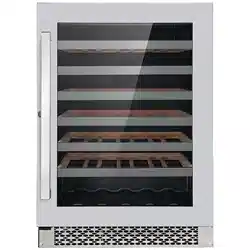Loading ...
Loading ...
Loading ...

20 21
WINE SERVING TEMPERATURE CHART
All wines mature at the same temperature, which is a constant temperature set
between 12ºC to 14ºC (54 to 57°F). The below chart is an indicative temperature
chart to indicate the best temperature for drinking purposes.
• Champagne NV, Sparkling, Spumante 6ºC 43 °F
• Dry White Semillon, Sauvignon Blanc 8ºC 46 °F
• Champagne Vintage, 10ºC 50 °F
• Dry White Chardonnay 10ºC 50 °F
• Dry White Gewürztraminer, Riesling, Pinot grigio 10ºC 50 °F
• Sweet White Sauternes, Barsac, Montbazillac, Ice Wine, Late Harvest 10ºC 50 °F
• Beaujolais 13ºC 55 °F
• Sweet White Vintage: Sauternes… 14ºC 57 °F
• White Vintage Chardonnay 14ºC 57 °F
• Red Pinot Noir, 16ºC 61 °F
• Red Grenache, Syrah 16ºC 61 °F
• Red Vintage Pinot Noir 18ºC 64 °F
• Cabernet & Merlot: French, Australian, New Zealand, 20ºC 68 °F
• Chilean, Italian, Spanish, Californian, Argentinean…
Vintage Bordeaux … Room temperature not exceeding 20ºC 68 °F
IMPORTANT INFORMATION ABOUT TEMPERATURE
Your wine cellar has been designed to guarantee optimum conditions for storing
and/or serving your wines. Fine wines require long and gentle developments
and need specific conditions in which to reach their full potential.
All wines mature at the same temperature, which is a constant temperature set
between 12ºC to 14ºC (54 to 57°F) . Only the temperature of “dégustation” (wine
appreciation) varies according to the type of wines (see “Wine Serving Tempera-
ture Chart” above). This being said and as it is for natural cellars used by wine
producers for long period of storage, it is not the exact temperature that is important,
but its consistency. In other words, as long as the temperature of your wine cellar
is constant between (12ºC to 14ºC) (54 to 57°F) your wines will be stored in perfect
conditions.
Not all wines will improve over the years. Some should be consumed at an early
stage (2 to 3 years) while others have tremendous ageing capability (50 and
over). All wines have a peak in maturity. Do check with your wine merchant to
get the relevant information.
CLEANING YOUR WINE COOLER
IMPORTANT: Always unplug the unit before cleaning or performing mainte-
nance. Never use harsh cleansers or scouring pads to clean any part of the unit.
Turn off the power, unplug the appliance, and remove all items including shelves.
Wash the inside surfaces with a warm water and baking soda solution. The
solution should be about 2 tablespoons of baking soda to a quart of water.
Wash the shelves with a mild detergent solution.
Wring excess water out of the sponge or cloth before cleaning control panels or
any electrical parts. Wash the outside cabinet with warm water and mild liquid
detergent. Rinse well and wipe dry with a clean soft cloth
POWER FAILURES
In the event of a power interruption, all previous temperature settings are
automatically preservation and it will revert to a preset temperature setting.
(See preset chart)
Most power failures are corrected within a short period of time. An hour or two’s
loss of power will not affect wine cellar’s temperatures. To avoid sudden change
of temperature while the power is off, you should avoid opening the door. For
longer period of power failure, do take steps to protect your wine.
Irrespective of the cause, if you notice either abnormal temperature or humidity
levels inside your wine cellar, be reassured that only long and frequent exposure
to these abnormal conditions can cause a detrimental effect on your wines.
TROUBLESHOOTING GUIDE
Common problems may easily be solved, saving you the cost of a possible
service call. Please read carefully the instruction manual and revert to
troubleshooting guide chart.
PROBLEM POSSIBLE CAUSE
Wine cellar does not operate. Not plugged in.
The appliance is turned off.
The circuit breaker tripped or the fuse is
broken.
Wine cellar is not cold enough. Check the temperature control setting.
External environment may require
a higher setting.
The door is opened too often.
The door is not closed completely.
The door gasket does not seal properly.
Turns on and off frequently. The room temperature is hotter than
normal.
A large amount of contents has been
added to the Wine cellar.
The door is opened too often.
The door is not closed completely.
The temperature control is not set correctly.
The door gasket does not seal properly.
Loading ...
Loading ...
Loading ...
